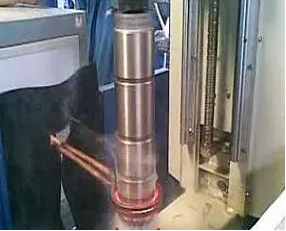- 20
- Jun
Operation specification requirements for high frequency quenching equipment
Operation specification requirements for cov khoom siv hluav taws xob ntau zaus
1. Cov neeg ua haujlwm ntawm cov khoom siv hluav taws xob ntau zaus yuav tsum dhau qhov kev xeem thiab tau txais daim ntawv pov thawj kev ua haujlwm ua ntej lawv tso cai rau kev khiav haujlwm. Tus neeg teb xov tooj yuav tsum paub txog kev ua haujlwm thiab cov qauv ntawm cov khoom siv, thiab yuav tsum ua raws li kev nyab xeeb thiab kev hloov pauv;
2. There must be more than two people to operate the high-frequency quenching equipment, and the person in charge of the operation must be designated;
3. When operating the high-frequency quenching equipment, check whether the protective shield is in good condition, and idle people are not allowed to enter during work to avoid danger;
4. Before working, check whether the contact of each part of the equipment is reliable, whether the quenching machine tool is running well, and whether the mechanical or hydraulic transmission is normal;
5. When preparing to turn on the water pump during work, check whether the cooling water pipes are smooth and whether the water pressure is between 1.2kg-2kg. Be careful not to touch the cooling water of the equipment with your hands;
6. The power transmission preheating is performed at the first stage, the filament is preheated for 30min-45min, and then the second stage is performed, and the filament is preheated for 15min. Close and continue to adjust the phase shifter to high voltage. After adding high frequency, hands are not allowed to touch the busbars and inductors;
7. Install the sensor, turn on the cooling water, and drain the workpiece before the sensor can be energized and heated, and no-load power transmission is strictly prohibited. When replacing the workpiece, the high frequency must be stopped. If the high frequency cannot be stopped, the high voltage should be cut off immediately or the emergency switch should be connected;
8. During the operation of the high-frequency quenching equipment, it should be noted that the positive flow and the powder flow are not allowed to exceed the specified value;
9. When working, all the doors should be closed. After the high voltage is closed, do not move to the back of the machine at will, and it is strictly forbidden to open the door;
10. Yog tias qhov tshwm sim txawv txav tau pom nyob rau hauv cov txheej txheem ua haujlwm ntawm cov khoom siv high-frequency quenching, lub high voltage yuav tsum raug txiav tawm ua ntej, thiab tom qab ntawd cov kev ua txhaum yuav tsum tau soj ntsuam thiab tshem tawm.
11. Chav tsev yuav tsum tau nruab nrog cov cuab yeej ua pa kom tshem tawm cov pa taws thiab cov pa khib nyiab tawm thaum lub sij hawm quenching thiab tiv thaiv ib puag ncig. Qhov ntsuas kub sab hauv tsev yuav tsum tswj ntawm 15-35 ° C.
12. Tom qab ua hauj lwm, ua ntej disconnect lub anode voltage, ces txiav tawm lub filament fais fab mov, thiab mus txuas ntxiv muab dej rau 15min-25min, kom cov hluav taws xob raj yog tag nrho txias, thiab ces ntxuav thiab xyuas cov khoom, kom huv si thiab qhuav los tiv thaiv cov khoom hluav taws xob los ntawm kev tawm thiab tawg. Thaum qhib lub qhov rooj rau kev tu, tso tawm cov anode, kab sib chaws, capacitor, thiab lwm yam ua ntej.

